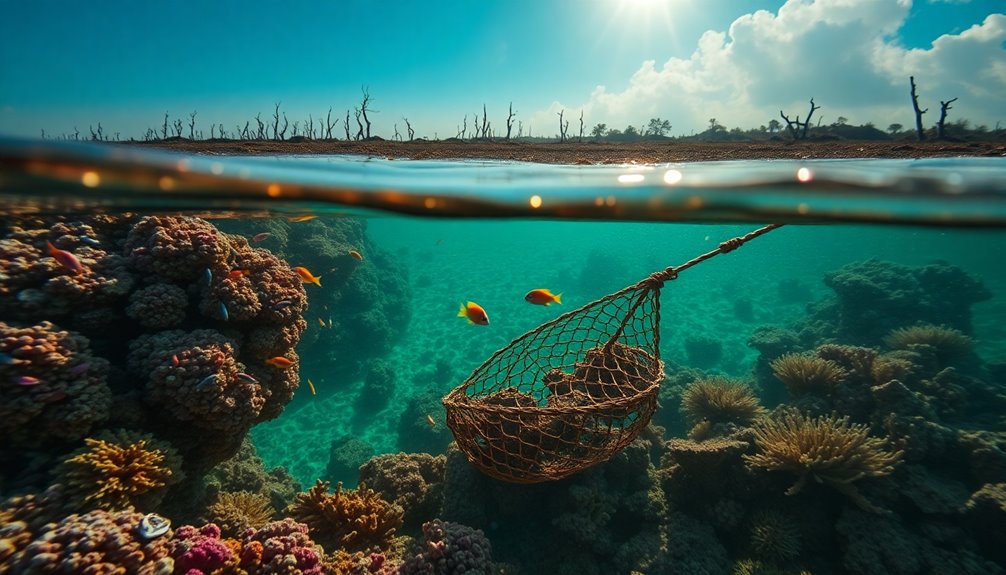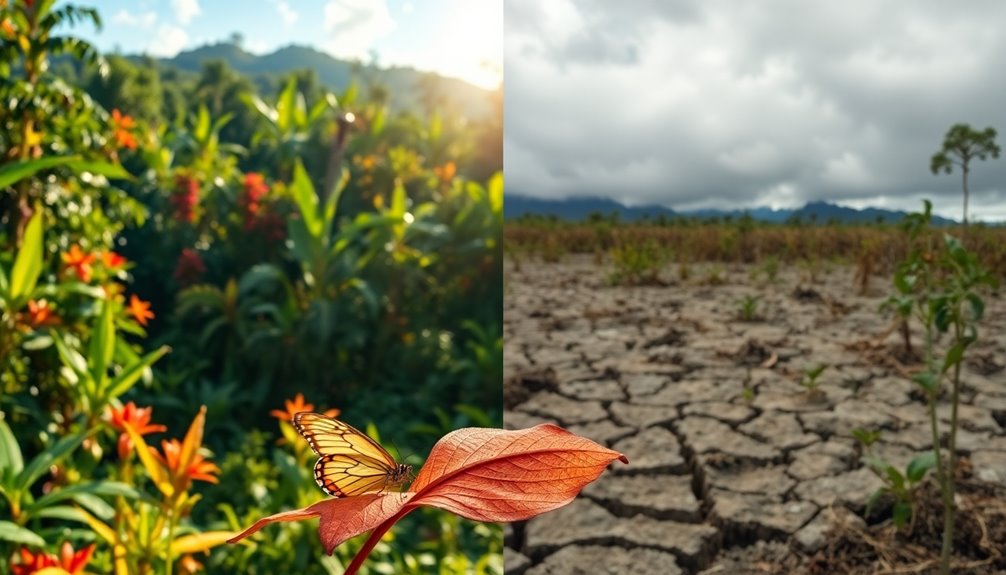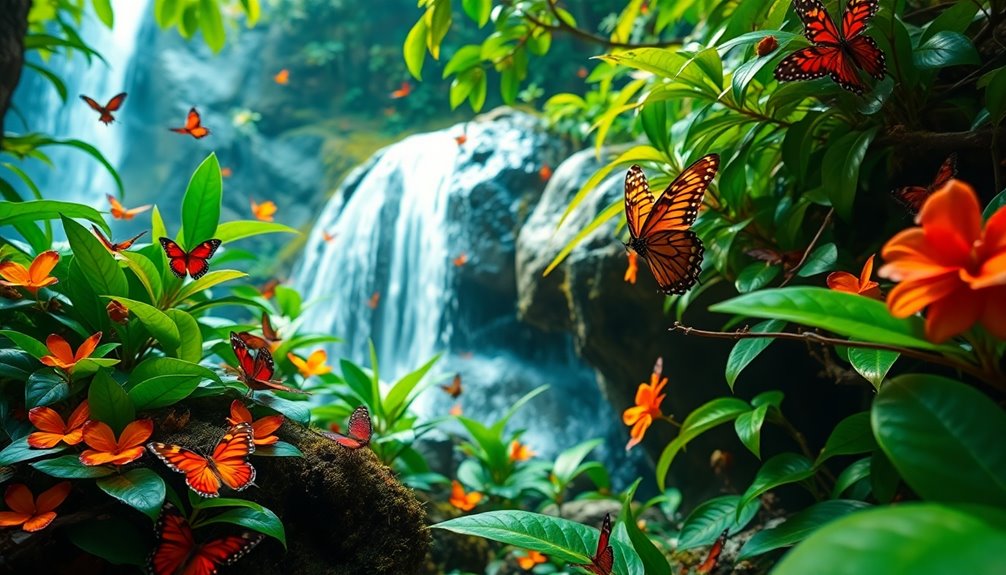Biodiversity refers to the variety of life on Earth, including genetic, species, and ecosystem diversity. It's crucial for healthy ecosystems, food production, and climate regulation. Unfortunately, activities like habitat destruction, pollution, and climate change are driving a significant loss of biodiversity, threatening over one million species by 2050. This decline hampers essential services, costs the economy, and destabilizes ecosystems. To protect biodiversity, you can support local initiatives and advocate for sustainable practices. By understanding what biodiversity is and why it matters, you're taking the first step to make a difference and discovering how to act responsibly for our planet.
Key Takeaways
- Biodiversity includes genetic, species, and ecosystem diversity, essential for ecological balance and resilience against disturbances like climate change.
- It provides critical services like clean water, pollination, and climate regulation, valued between $125 to $140 trillion annually.
- Human activities, such as habitat destruction and pollution, are the primary drivers of biodiversity loss affecting 75% of land.
- Climate change threatens over one million species with extinction by 2050, disrupting ecosystems and hindering carbon sequestration.
- Protecting biodiversity requires collective action, supporting local initiatives, and involving Indigenous communities in conservation efforts.
What Is Biodiversity?

Biodiversity is the rich tapestry of life on Earth, encompassing the wide-ranging variety of organisms that inhabit our planet. It consists of three main levels: genetic diversity, species diversity, and ecosystem diversity.
You might be surprised to learn that there are approximately 8.7 million species, though only around 1.75 million are officially cataloged. Each ecosystem, whether it's a forest, wetland, or ocean, contributes uniquely to ecological balance and supports various species.
Healthy ecosystems with high biodiversity are essential for food production and climate regulation. They exhibit greater resilience to changes, allowing them to withstand disturbances like climate change and pollution.
Understanding biodiversity's intricacies helps you appreciate its role in maintaining our planet's health.
Importance of Biodiversity

The rich variety of life on Earth plays an essential role in maintaining the health of ecosystems.
Biodiversity provides critical services like clean water, climate regulation, and pollination, which are fundamental for food production and human survival. About 75% of the world's crops rely on animal pollination, emphasizing how important diverse species interactions are for global food security.
Healthy ecosystems, bolstered by biodiversity, are more resilient to challenges like climate change and diseases.
This diversity also considerably contributes to the global economy, with ecosystem services valued at $125 to $140 trillion annually.
Protecting biodiversity isn't just about ecological balance; it's imperative for sustaining human livelihoods and promoting sustainable practices that benefit the entire human population.
Causes of Biodiversity Loss

As human activities continue to reshape our planet, they've become the primary drivers of biodiversity loss. Habitat destruction for agriculture and urbanization has altered 75% of land-based and 66% of marine ecosystems.
Climate change accelerates this loss, as many species struggle to adapt to rapidly changing conditions. Pollution from industrial waste and agricultural runoff contributes greatly, with 300-400 million tons contaminating water bodies each year.
Invasive species further threaten native species by outcompeting them and altering habitats. Finally, overexploitation, such as overfishing and wildlife trafficking, places immense pressure on numerous species, with illegal wildlife trade valued at around $10 billion annually.
Together, these factors create a dire situation for biodiversity and the health of our ecosystems.
Climate Change Effects

While climate change poses a significant threat to ecosystems worldwide, its effects on biodiversity are particularly alarming. You're witnessing a rapid loss of biodiversity, with over one million species at risk of extinction by 2050. Many species are shifting their geographical ranges to find cooler climates, which disrupts ecosystems. This loss hampers essential ecosystem services like carbon sequestration, jeopardizing climate regulation. Coral reefs, critical marine ecosystems, face severe bleaching events, threatening both marine life and local economies. The projected $2.7 trillion drop in global GDP by 2030 due to ecosystem collapse highlights the economic stakes. Additionally, coastal zones are increasingly affected by climate change, leading to heightened risks for marine life and beach ecosystems.
| Effect | Impact on Biodiversity | Economic Consequence |
|---|---|---|
| Habitat degradation | Increased extinction | Loss of ecosystem services |
| Geographical shifts | Altered ecosystems | Reduced global GDP |
| Coral reef bleaching | Marine biodiversity loss | Threat to tourism |
Actions for Protection

Protecting biodiversity requires collective action and commitment from everyone. You can support conservation by engaging in local initiatives, like creating native plant gardens that enhance ecosystem resilience.
Advocate for policies that protect habitats and reduce carbon emissions, as these are essential to combat climate change and biodiversity loss. Participate in citizen science projects to contribute to biodiversity monitoring, providing important data for effective strategies.
Elevating Indigenous communities in conservation efforts is significant since they manage substantial biodiversity-rich lands.
Finally, take urgent steps to minimize plastic pollution and prevent the spread of invasive species, which threaten native ecosystems and species diversity. Engaging in educational toys can also inspire a love for nature and foster awareness about the importance of preserving biodiversity in young children.
Together, these actions can foster healthier ecosystems and guarantee the sustainability of indispensable ecosystem services.
Frequently Asked Questions
What Are the 5 Importance of Biodiversity?
Biodiversity's importance can't be overstated.
First, it supports ecosystem health, ensuring clean air and water.
Second, it boosts food security by enabling pollination for many crops.
Third, diverse ecosystems enhance resilience against climate change.
Fourth, they provide economic benefits, contributing over $125 trillion annually.
Finally, biodiversity enriches cultural and spiritual well-being, connecting communities to nature.
What Are the 5 Components of Biodiversity?
Did you know that the Amazon rainforest is home to about 10% of all known species on Earth?
The five components of biodiversity you should explore are genetic diversity, species diversity, ecosystem diversity, functional diversity, and biosphere interactions.
Each plays a vital role in maintaining ecological balance and resilience. By understanding these components, you can better appreciate how they contribute to the health and stability of our planet's ecosystems.
What Are the Basics of Biodiversity?
Biodiversity refers to the variety of life forms on Earth, including the different species, genetic variations, and ecosystems.
It's vital for maintaining healthy environments that provide essential services like clean air, water, and food.
You should know that biodiversity isn't just about the number of species but also their interactions within ecosystems.
Unfortunately, human activities are threatening this balance, leading to significant loss, which ultimately impacts our survival and quality of life.
What Are the 5 Factors of Biodiversity?
When you think about biodiversity, consider its five key factors: genetic, species, ecosystem, functional, and spatial diversity.
Genetic diversity allows species to adapt and survive. Species diversity boosts ecosystem stability. Ecosystem diversity provides various habitats. Functional diversity maintains essential processes like pollination.
Finally, spatial diversity influences how species and ecosystems interact. Each factor plays a crucial role in the overall health and resilience of our planet's ecosystems, making them interconnected and essential.
Conclusion
In the grand tapestry of life, biodiversity is the vibrant thread that weaves everything together. Without it, our planet's beauty fades into a dull gray. By understanding its value and the threats it faces, you can become a guardian of nature, nurturing the colorful mosaic that sustains us all. Let's roll up our sleeves and protect this precious ecosystem, ensuring future generations can dance under the kaleidoscope of life. Together, we can turn the tide for our planet!









